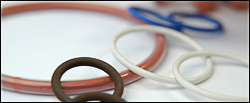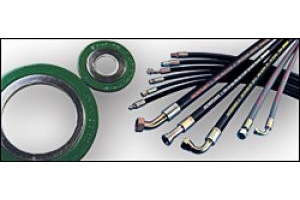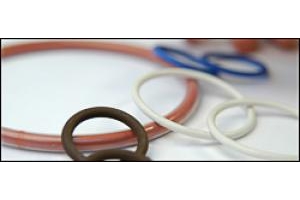O-ring
Technical Information
What is an O-ring?
An O-ring is a simple and versatile ring-shaped packing and sealing device with a circular cross section.
O-ring functions as compact and reliable sealing devices by absorbing the tolerance stack-up between closely mated surfaces in both dynamic and static applications. Although O-rings can be made from a variety of materials, they are most commonly molded in one piece from an elastomeric material.
What is an O-ring seal?
O-ring seal is used to prevent the loss of a fluid and gas between two closely spaced surfaces. The O-ring is generally installed in a machined groove in one of the surfaces to be sealed. As the two surfaces are brought together, forming a gland, they squeeze the cross section of the O-ring. This squeezing action results in a deformation of the O-ring cross section. With O-rings, the greater the squeeze, the larger the deformation.
Listed below are some of the outstanding characteristics that make O-rings one of the most versatile, dependable, yet inexpensive seals available, with sealing capability from hard vacuum to high pressure.
- They seal over a wide range of pressure, temperature and tolerance
- Ease of service, no smearing or retightening
- No critical torque on tightening, therefore unlikely to cause structural damage
- O-rings normally require very little room and are light in weight
- In many cases an O-ring can be reused, and advantage over non-elastic flat seals and crush-type gaskets
- The duration of life in the correct application corresponds to the normal aging period of the O-ring material
- O-ring failure is normally gradual and easily identified
- They are cost-effective
- Where differing amounts of compression effects the seals function, an O-ring is not effected because metal to metal contact is generally allowed for.
- O-ring compounds can be selected to resist most environmental extremes
It is a unique characteristics of the elastomer material used in O-rings that makes O-ring such a good seal. The elastomer, a highly viscous, incompressible fluid with high surface tension, has a capacity for remembering its original shape for a long time.
In low-pressure applications (that is, where the confined fluid exerts little or no pressure on the O-ring), the tendency of the elastomer to maintain its original shape creates the seal. As the O-ring is deformed when the mating surfaces are brought together, it exerts a force against the mating surfaces equal to the force it takes to squeeze it. The areas of contacts between the O-ring and the mating surfaces (contact bands) act as a barrier to block the passage of the fluid.
In applications where higher pressure is exerted by the confined fluid, the sealing action of the O-ring caused by the squeeze of its cross-section is augmented by fluid pressure, transmitted through the elastomer. The O-ring is forced to the side of the gland, away from the pressure. As it is pressed against the side, the O-ring, cross section is deformed. The elastomer exerts equal force in all directions and is forced up to the gap between the mating surfaces.
When pressure is released, the O-ring returns to approximately its original installed shape, ready for the next application of pressure. The O-ring is also able to seal in both directions. In a double acting system where the pressure application changes from one side of the O-ring to the other, the O-ring moves, seating itself in the opposite side of the gland.
If pressure exceeds the limits of the O-ring, or if the gap that the O-ring must block is too large, the elastomer will enter the narrow gap between the inner and outer members of the glad. This may result in failure, causing the fluid to leak.
Hydraulic Hoses
O-ring
ID Doanh nghiệp: G-00073981
Địa chỉ:
Điện thoại: 0906 468 576
Email: [email protected]
Website: http://www.toparts.com

(Trong khuôn viên Tổng Công Ty Thái Sơn - Bộ Quốc Phòng)
Điện thoại: 028 6658 9888
Email: [email protected]









